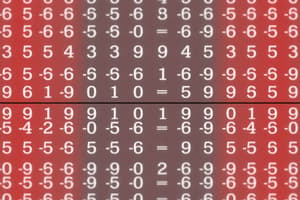Podcast
Questions and Answers
What characterizes the set Sn+ of matrices?
What characterizes the set Sn+ of matrices?
- All matrices in Sn+ are symmetric and invertible.
- All matrices in Sn+ satisfy the condition zTXz ≥ 0 for all vectors z. (correct)
- All matrices in Sn+ are singular.
- All matrices in Sn+ have at least one negative eigenvalue.
Which of the following statements is true regarding Sn++?
Which of the following statements is true regarding Sn++?
- Matrices in Sn++ are always symmetric but not necessarily positive semidefinite.
- All matrices in Sn++ can have zero as an eigenvalue.
- Sn++ is a subset of Sn+. (correct)
- Matrices in Sn++ are characterized by having positive eigenvalues. (correct)
Why is Sn+ considered a convex cone?
Why is Sn+ considered a convex cone?
- It has matrices that do not change under transposition.
- It contains only positive definite matrices.
- It consists solely of symmetric matrices.
- It is closed under scalar multiplication and addition of its matrices. (correct)
Which of these matrices example does belong to S2+?
Which of these matrices example does belong to S2+?
What is the condition for a matrix to be in Sn+?
What is the condition for a matrix to be in Sn+?
What is the significance of the parameter θ in the expression $x = θx1 + (1 − θ)x2$?
What is the significance of the parameter θ in the expression $x = θx1 + (1 − θ)x2$?
Under what condition is a set considered an affine set?
Under what condition is a set considered an affine set?
Which value of θ would place the point x exactly at x1?
Which value of θ would place the point x exactly at x1?
What relationship exists between an affine set and the solution set of linear equations?
What relationship exists between an affine set and the solution set of linear equations?
Which of the following values for θ represents a point outside the segment between x1 and x2?
Which of the following values for θ represents a point outside the segment between x1 and x2?
Flashcards
Symmetric Matrix
Symmetric Matrix
A square matrix where the transpose equals the original matrix.
Positive Semidefinite Matrix
Positive Semidefinite Matrix
A matrix where any vector's quadratic form is non-negative.
Convex Cone (Sn+)
Convex Cone (Sn+)
Positive semidefinite matrices form a set where the sum of matrices in the set is also a matrix in that set.
Positive Definite Matrix
Positive Definite Matrix
Signup and view all the flashcards
Line Equation
Line Equation
Signup and view all the flashcards
Affine Set
Affine Set
Signup and view all the flashcards
Affine Set Example
Affine Set Example
Signup and view all the flashcards
Quadratic Form
Quadratic Form
Signup and view all the flashcards
Positive Semidefinite Matrix, example in S2+
Positive Semidefinite Matrix, example in S2+
Signup and view all the flashcards
θ's Impact in Geometric Equation
θ's Impact in Geometric Equation
Signup and view all the flashcards
Study Notes
Symmetric Matrices
- Sn represents the set of symmetric n × n matrices.
- Symmetric matrices are those where the transpose equals the original matrix (X = X^T).
Positive Semidefinite Matrices
- Sn+ comprises positive semidefinite n × n matrices (X ∈ Sn | X ⪰ 0).
- A matrix X is considered positive semidefinite if z^T X z ≥ 0 for all vectors z.
- This condition implies that the quadratic form defined by the matrix X is non-negative.
Convex Cone
- Sn+ forms a convex cone, meaning that if two positive semidefinite matrices are combined through linear combinations, the result will also be a positive semidefinite matrix.
Positive Definite Matrices
- Sn++ denotes the set of positive definite n × n matrices (X ∈ Sn | X ≻ 0).
- A positive definite matrix is more restrictive than a semidefinite one and satisfies z^T X z > 0 for all non-zero vectors z.
Example
- An example of a positive semidefinite matrix in S2+ is {{x, y}, {y, z}}, where elements must satisfy the positive semidefinite condition.
Line through Points x1 and x2
- The equation representing points along the line between two points (x_1) and (x_2) is given by (x = \theta x_1 + (1 - \theta)x_2), where (\theta) is a real number.
- The parameter (\theta) affects the position of point (x) on the line:
- When (\theta = 1.2), point (x) is beyond (x_2).
- When (\theta = 1), point (x) coincides with (x_2).
- When (\theta = 0.6), point (x) is positioned near both (x_1) and (x_2) but closer to (x_2).
- When (\theta = 0), point (x) coincides with (x_1).
- When (\theta = -0.2), point (x) is extended beyond (x_1).
Affine Sets
- An affine set is defined as containing the line through any two distinct points within the set.
- Example of an affine set includes solution sets to linear equations represented as: ({x | Ax = b}).
- Each affine set corresponds to a solution set of a system of linear equations, showcasing their dual relationship.
Studying That Suits You
Use AI to generate personalized quizzes and flashcards to suit your learning preferences.



